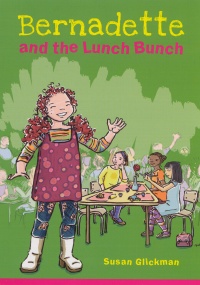| ________________
CM . . . . Volume XV Number 13. . . .February 20, 2009. 
 |
Bernadette and the Lunch Bunch.
Susan Glickman. Illustrated by Mélanie Allard.
Toronto, ON: Second Story Press, 2008.
123 pp., pbk., $6.95.
ISBN 978-1-897187-51-7.
Subject Headings:
Schools-Juvenile fiction.
Friendships-Juvenile fiction.
self-acceptance-Juvenile fiction.
Grades 2-4 / Ages 7-9.
Review by Jonine Bergen.
**/4
|
| |
|

excerpt:
Bernadette didn't answer her, because she was so mad. Why did all the adults keep telling her she had to be patient? Why did they keep saying that next year's science fair was only a year away, as though that was really soon? A year was not soon. A year was as distant as Africa, as impossible as breathing underwater, as lonely as an empty house. How was Bernadette Inez O'Brian Schwartz-who not only wanted to be a scientist when she grew up, but knew she had been a scientist since the day she was born-suppose to wait a whole entire year?
Bernadette Inez O'Brian Schwartz had been looking forward to grade three for a long, long time. In grade three, students are finally able to complete a science project for the annual science fair. For a girl who uses her kitchen as a laboratory - indeed, whose first, second, and third word was "why" - science is a very big deal.
Unfortunately, circumstances are conspiring against Bernadette this year. To begin with, her best friend, Jasmine, moves away before school starts. This tragedy causes Bernadette to declare that this is going to be the worst year ever; and Bernadette is stubborn and single-minded enough to
make sure this hypothesis is proven accurate.
To add to this already dreadful situation, Bernadette learns she is going to have to stay at school for lunch where she has to sit beside the terrible Jackie Renfrew who wants to trade lunches with her. Next, Mrs. Hawthorn, who should have been a great teacher because she teaches science, is bossy, strict, and gives detentions to the whole class when they misbehave - even Bernadette.
Then, the very worst thing happens. Bernadette finds out she can't take part in the science fair after all because a silly grade three student last year was burned during an experiment.
Since things can't possibly get any worse, Bernadette finally decides to step out of her comfort zone and try to make friends with some of the girls in her class. Together, with her new friends, Annie, Megan, and Keisha, Bernadette forms the Lunch Bunch. Although Bernadette remains
disappointed about the science fair, she begins to use her creativity and organizational talents to create fun for the Lunch Bunch, and in the process she learns to appreciate people's differences. Perhaps, she will even find a strategy to change the administration's mind about allowing grade
three students to participate in the science fair.
Susan Glickman has created a credible heroine in Bernadette Inez O'Brian Schwartz whose curiosity and drive are as long as her name. Bernadette's portrayal as a single-minded, dramatic girl full of "strategies" who is determined to change an unjust decision is completely believable. Indeed, her over-the-top exaggerations are what one might expect from an incorrigible, imaginative eight-year-old.
The plot, like Bernadette, is methodical. Each chapter is based on an episode within the school year that shows Bernadette's ability to plan and organize people. More importantly, as Bernadette starts to interact with the other students, she starts to see her classmates as individuals, with
their own insecurities and special talents.
Despite Susan Glickman's effective characterization and well structured episodes, Bernadette and the Lunch Bunch fell flat for me. To emphasize Bernadette's disappointment, Glickman overuses repetition. The first third of the novel is used to emphasize how frustrated and unhappy
Bernadette is - a fact the reader is reminded of in nearly every subsequent chapter. This repetition, though necessary to some degree, becomes tedious and ultimately turns Bernadette into a whiner.
This redundancy exists at the chapter level as well. Though well-structured vignettes, some of the chapters are not necessary for character or plot development. Indeed, Bernadette and the Lunch Bunch feels too long for this age group.
The text block does not invite the reader into the story either. Paragraphs are long; many over half a page. The chapters and the sentences are similarly long. Furthermore, the charming black and white sketches by Mélanie Allard are sparsely used - some chapters don't have any. The drawings do invite and assist the reader in interpreting the text, but there just aren't enough of them.
Bernadette and the Lunch Bunch is appropriate for the student who has already mastered reading and is comfortable with novels. In short, though the plot is appropriate for the 7-9 age group, Glickman's writing is better suited to the 8-10 age group. The early and intermediate reader may find Bernadette and the Lunch Bunch intimidating. That being said, it does
have a reading fluency helpful in a read-aloud.
The precocious Bernadettes of the world may relate to Susan Glickman's first novel for children. However, the rest of the seven and eight year olds may find themselves as frustrated as Bernadette was when told she couldn't participate in the science fair.
Recommended with reservations.
Jonine Bergen works as a library technician in Winnipeg, MB.

To comment on this title or this review, send mail to
cm@umanitoba.ca.
Copyright © the Manitoba Library Association. Reproduction for personal use is permitted only if this copyright notice is maintained. Any other reproduction is prohibited without permission.
NEXT REVIEW |
TABLE OF CONTENTS FOR THIS ISSUE- February 20, 2009.
AUTHORS |
TITLES |
MEDIA REVIEWS |
PROFILES |
BACK ISSUES |
SEARCH |
CMARCHIVE |
HOME |
